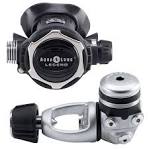Now that we've explored and defined the basic parts and functioning of a scuba regulator, let's explore the various types of regulators and their features.
The regulator lowdown:
First Stage scuba regulators can be separated into two basic groups: diaphragm regulators and piston regulators.
 Diaphragm Regulators
Diaphragm Regulators
Diaphragm refers to a thick piece of plastic rubber within the first stage that is basically pushed open and closed by metal springs on either side of it. Diaphragm regulators do have more moving parts than piston regulators, but does not make much difference to the recreational diver. Diaphragm regulators are also "environmentally sealed," meaning that no water enters into the inner workings of the first stage, making this the preferred choice for both cold water divers and those diving in contaminated waters.
 Piston Regulators
Piston Regulators
Piston refers to a piston inside of the first stage of the regulator that moves up and down against a heavy tensioned spring. Once the IP (Intermediate Pressure) is reached inside the first stage, airflow into the regulator from the tank stops. When the diver takes a breath and the IP drops, the spring opens up the piston and allows air to flow back into the regulator. Water is allowed to flow inside of a piston first stage so divers must be more diligent in rinsing this regulator after diving.
Within both of the main two scuba regulator groups (diaphragm and piston) the regulator can now either be "balanced" or "over-balanced."
Balanced Regulators
A Balanced First Stage is when the intermediate pressure stays consistent even when reaching great depths. It also ensures that the IP stays true even when the tank pressure is getting low.
Overbalanced Regulators
Overbalanced regulators allow the inter-stage pressure in the hose to increase more than a balanced regulator at depth. This compensates for the increased density of the air at depth, therefore, allowing larger volumes of air to pass to the diver. This gives better breathing performance to the diver.
Once you've decided on a piston or diaphragm regulator, and whether you want it to be balanced or over-balanced, the rest of your decision will be based on how many "bells-and-whistles" you want it to have. Obviously, the more features you want you your regulator, the higher the price you will pay for them; it's just like buying a car. These are the most common features, and what they can do for you:
Venturi Valve
An adjustment valve on the second stage of many regulators that allows the diver to fine tune the effort needed to take a breath from their regulator.
Master Breathing System
Found on Aqua Lung Legend Luxe and Legend LX Regulator models. A control knob that combines the Venturi and fine adjustment knob into one easy to use control knob minimizing regulator free flow at the surface and fine tuning inhalation effort during your dive.
Auto Closure Device
Found on Aqua Lung regulators, seals off the regulator's first stage, keeping water and other contaminants from entering. Also makes the regulator safer for higher percentages of oxygen use.
Pneumatically Balanced Second Stage
Eases the exertion effort needed by the diver to take in a breath of air, increasing the ease of breathing during all stages of diving from shallow to deep.
Automatic Flow Control
Found in Atomic regulators, this design actually eliminates the need for a venturi valve on the second stage by placing a computer-designed air foil inside of the mouthpiece connected to pressure sensing diaphragm, allowing the airfoil to adjust automatically as your depth changes.
Now that you can throw down technical regulator terms with the best of them, you can make a list of features you want and feel confident walking into your dive store and discussing with the sales associate about which regulator is best for you. Now get out there and blow some bubbles!


